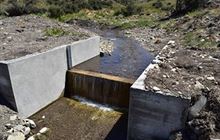Non-migratory galaxiids
Introduction
Non-migratory galaxiids belong to an ancient, scaleless fish family called Galaxiidae – for the galaxy-like gold flecks and patterns on their backs.Unlike whitebait, which migrate to sea, some non-migratory galaxiid species live out their entire life in the stream or river in which they hatched.
Over millennia, these populations of galaxiids were isolated by geological events such as earthquakes and glacial movement. They evolved into distinct species, each with their own individual features and stories.
Image gallery
-
Gollum galaxias Image: Rod Morris ©
![Gollum galaxias. Gollum galaxias.]()
-
Canterbury galaxias Image: Rod Morris ©
![Canterbury galaxias - freshwater fish. Canterbury galaxias - freshwater fish.]()
-
Central Otago roundhead galaxias Image: Rod Morris ©
![Central Otago roundhead galaxias. Central Otago roundhead galaxias.]()
-
Clutha flathead galaxias Image: Rod Morris ©
![Clutha flathead galaxias. Clutha flathead galaxias.]()
-
Dusky galaxias Image: Simon Madill ©
![Dusky galaxias. Dusky galaxias.]()
-
Eldon’s galaxias Image: Rod Morris ©
![Eldon’s galaxias. Eldon’s galaxias.]()
-
Lowland longjaw galaxias Image: Rod Morris ©
![Lowland longjaw galaxias. Lowland longjaw galaxias.]()
-
Nevis galaxias Image: Rod Morris ©
![Nevis galaxias. Nevis galaxias.]()
-
Taieri flathead galaxias Image: Rod Morris ©
![Taieri flathead galaxias. Taieri flathead galaxias.]()
-
Teviot flathead galaxias Image: Simon Madill ©
![Teviot flathead galaxias. Teviot flathead galaxias.]()
Species
There are 12 species of non-migratory galaxiids and a further 13 indeterminate taxa recognised in New Zealand.
These fish are not well known, and it is difficult to tell non-migratory galaxiids species apart. Some species are only found in one or two rivers and all have a threatened or at risk conservation status.
The 12 species of non-migratory galaxiids are:
- Alpine galaxias (Canterbury, Marlborough, West Coast)
- Bignose galaxias
- Canterbury galaxias
- Central Otago roundhead galaxias
- Dusky galaxias
- Dwarf galaxias (West Coast)
- Dwarf inanga (North Kaipara Head dune lakes)
- Eldon’s galaxias
- Gollum galaxias
- Lowland longjaw galaxias (Kakanui River)
- Taieri flathead galaxias
- Upland longjaw galaxias (Canterbury, West Coast)
A further 13 recognised taxonomically indeterminate species of non-migratory galaxiids are:
- Lowland longjaw galaxias (Waitaki River)
- Upland longjaw galaxias (Waitaki River)
- Alpine galaxias (Manuherikia River)
- Alpine galaxias (Southland)
- Clutha flathead galaxias
- Dune lakes galaxias (Kai Iwi Lakes)
- Dwarf galaxias (Nelson, Marlborough, North Island)
- Nevis galaxias (Nevis River)
- Northern flathead galaxias (Marlborough, Nelson, West Coast)
- Southern flathead galaxias (Southland Otago)
- Teviot flathead galaxias (Teviot River)
- Lower Clutha galaxias (Clutha River)
- Pomahaka galaxias (Pomahaka River)
In 2013, the current understanding of the taxonomic status of all non-migratory Galaxias taxa was determined at a DOC convened workshop. Participants at this workshop included geneticists, taxonomists, and conservation managers.
Thirteen non-migratory galaxiids are listed as taxonomically indeterminate and are awaiting formal description. However these have all been assessed for conservation status in the latest rerankings.
Otago: biodiversity hot spot
Otago is a biodiversity ‘hot spot’ for non-migratory galaxiids, and is home to 11 out of the 23 species. The streams and rivers that flow through Otago is the only place on Earth some of these fascinating freshwater fish can be found.
Threats
Many non-migratory galaxiids have highly fragmented populations with a number of local extinctions being confirmed in recent years, predominately in Otago and Canterbury. This is largely a result of invasive species invasion and habitat loss.
Additional threats facing our non-migratory galaxiids include:
- macrophyte and weed invasion
- reduction or altering water quantity/flows
- habitat destruction/alteration
- reduction in water quality.
DOC's work
The Department of Conservation has had some success with restoring key non-migratory galaxiid populations by removing invasive species and installing built barriers to prevent further invasion.
You can help
Here are some ideas for how you can help non-migratory galaxiids in your neighbourhood.
- When repairing or replacing culverts or structures in streams, talk to someone at DOC to make sure they’re compatible with protecting native fish. Barriers can help prevent certain non-migratory galaxiids from being eaten by other fish.
- Fence off spawning areas in spring.
- Protect breeding grounds by restoring and protecting vegetation on stream banks and wetlands. Planting alongside streams also helps create shade, which galaxiids love, and reduces nutrient run-off.
- Check, Clean and Dry to prevent the spread of aquatic pests – fish such as koi carp and aquatic weeds such as didymo can wreak havoc on our freshwater environments.











